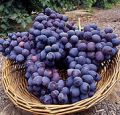 Wine flour promises taste, health benefits to bakers
Wine flour promises taste, health benefits to bakersBy Lorraine Heller Food Navigator USA
| |
11/21/2006 - A new wine flour manufactured from grape skins claims to allow manufacturers of baked goods, pasta and snacks to naturally fortify their products with healthy fatty acids and fiber.
Manufactured from a by-product of the wine industry, the flour is also marketed as containing high levels of iron and calcium, as well as the heart-healthy polyphenol resveratrol.
The product is obtained using a patent-pending drying process, applied to the grape pomace – or what is left of the fruit after it has been crushed for wine-making. Primarily made up of grape skins, together with a small amount of seeds, this by-product is dried, sifted and ground into a flour.
This can then be used in low concentrations as an added ingredient in any application where flour is normally used, said Vinifera For Life chief executive officer Mark Walpole.
For example, in bakery goods, such as breads, crackers, bagels or muffins, the wine flour is used at a concentration of 7-10 percent. In pasta it can be used at a concentration of up to 25 percent. And if the flour is ground finer, it can be incorporated into energy bars or even drinks, such as protein beverages or tea.
According to Walpole, a lifelong chef who grew up in a wine region and developed the flour through a series of experimentations, at these concentrations, the ingredient has no impact on a product's texture.
However, the wine flour does have a significant affect on taste and color, bringing a deep burgundy color to products, and a distinct, enhanced taste but no acidic aftertaste.
“The ingredient has three main marketing angles: it's nutrient profile, it's connection with health through the association with the health benefits of red wine, and the sheer romance of having a Cabernet bread or a Champagne cracker,” Walpole told FoodNavigator-USA.com.
Indeed, according to tests carried out by the
And market research conducted by the
However, the ingredient does not come cheap as a result of the expense involved in its production process. The flour is currently priced at around CA$12-$15 per kilo, depending on where it is sold.
For the time being, all sales have been concentrated in
“
“But at the start it's a slow process. This is a novel ingredient, there's no benchmark to place it against, so the road's been a tough one. Everyone is watching to see how we penetrate the market and what kind of success we have.”
For the time being, Vinifera For Life already has one major global bakery supplier interested in its product. According to
Once these products are commercialized, said
Vinifera For Life estimates its total production of the wine flour this year will be around 200 tons. And although next year's production will depend on market acceptability, the firm expects to churn out three times as much in 2007.
And once the company has built up a production infrastructure and has developed a market for its product, it expects to start applying its process to other flour products. These will include flours made from asparagus, peppers, egg plant, leak, carrot, parsley and green peas.
For more information on the wine flour, click here.




No comments:
Post a Comment